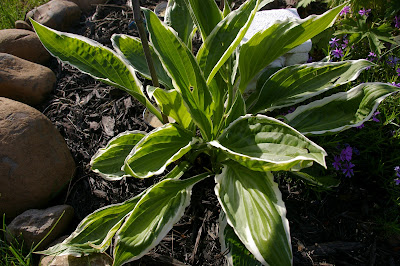 |
| Patriot |
Hostas
Purchased from Fred Meyer on 148th and Division Summer of 2010
1' tall x 2' wide
zones 3-9
lavender flowers in the summer
shade plant
loves soil rich in compost or animal manure
perennial
Hostas originally came from Japan, China, and Korea. They were first
introduced to Europe in the late 1700s and then came to the United
States in the middle 1800s.
Reaches maturity in 4-8 years
Blue leaved hostas require more shade than green and gold varieties, which can tolerate more sun
A balanced granular fertilizer such as 10-10-10 or 5-10-5 can be applied
early in the spring, followed by an application six weeks later,
followed by a midsummer application. Timing of these applications would
typically be early April, mid- to late May, and mid-July.
Extended release fertilizer is applied early in the spring. Extended release fertilizers such as Osmocote® or Sierra Blend® are rated for three, six, or nine months release times. However, heat and moisture may shorten the longevity of release. An early spring application of three or six months extended release fertilizer can be followed by an application of regular granular fertilizer in midsummer.
Liquid fertilizer is used for both soil and foliar application. It is applied every 7 to 10 days according to the fertilizer label instructions.
A minimum of an inch of water each week is recommended
Propagation of hostas is easily achieved by dividing existing plants. Division should be done when no shoots are growing from the center of
the mature clump and this bare area detracts from the appearance of the
plant. Division of the clump will improve the plant's appearance. Lift
the entire hosta clump and wash the soil from the roots, if possible, to
make it easier to see where to cut to divide the clump. Cut with a
sharp knife to make the divisions. Spring is the easiest time to divide plants because new shoots are only a
few inches high and the leaves have not expanded. Be careful not to
over divide hostas in spring; divide only the fast growing hostas then.
Very susceptible to slugs! One method to try: laying wet newspapers on the ground overnight. Check beneath these the
next day to find slugs that have taken refuge from heat and sun. Kill
the slugs by dropping them into a 10-20% solution of ammonia and water.
Salt will also kill slugs if applied directly to them. Slug bait helps control them.






No comments:
Post a Comment